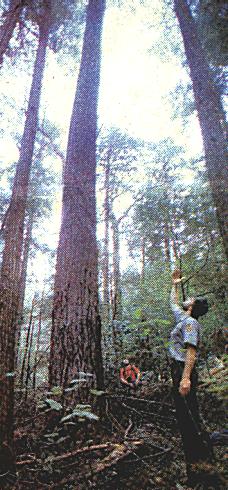|
By BEVERLY PEARMAN
Assistant news editor-Waynesville Enterprise Mountaineer
CATALOOCHEE VALLEY -
Mother Nature may have trimmed its crown by 35 feet, but at 170 feet, the white
pine in Cataloochee Valley is still a majestic sight to behold.
This "tree of peace", as it is referred to by some Native
American tribes, stood at 207 feet when it was "discovered" last
August by tree sleuths, Will Blozan and Bob Leverett. At this height it was the
tallest tree in the eastern United States. But Hurricane Opal and the winter's
ice trimmed its top by about 35 feet. On Thursday (May 2, 1996) about 20
members of Western North Carolina Alliance gathered near at its base on the
Caldwell Fork Trail in the Great Smoky Mountains National Park to honor the
standing giant.
|

National Park Service employee Will Blozan looks up to the top
of an old-growth pine he "discovered" in Cataloochee Valley. The tree
was 207 feet tall when Blozan found it last August, but it is now 170 feet
after winter trimmed its crown by 35 feet.
|

Cherokee elder Walker Calhoun led a ceremony May 2, 1996
honoring old-growth trees.
|
The old-growth tree ceremony was led by Native Americans Walker
Calhoun, an Eastern Band Cherokee elder, and Johnie Leverett, whose mother was
Western Band Cherokee and father was Choctaw. Despite his soft-spoken
voice and small stature, Calhoun, 77, was the center of attention and
admiration as he sang traditional Cherokee prayer and dance songs in honor of
the tree. He learned the songs as a child from his elders, he said.
|
Bob Leverett said it was fitting for Calhoun and Johnie Leverett to lead the
ceremony since their people once lived in harmony with the trees, rather than
cutting them down in a rush to progress, as our society has.
"These great monarchs, these standing people, were everywhere
important to the people who were here then," Bob Leverett said of
old-growth trees. "This is the Cherokee home as I see it. They found a way
to live with (these giants)." Johnie Leverett was raised with the Plains
Indians and had only heard stories as a child about trees this large. She and
husband Bob now live in Massachusetts where she works with Algonquin and
Iroquois. Her Mohawk name translates to Standing Woman in English, and she said
her job is to educate people to respect the forest.
She brought messages from the northeastern tribes in the form of a story
about the pine tree and its role in creating peace. At one time, the five
Native American nations were constantly fighting to the point of clans being
wiped out. The peacemaker came and walked the earth and uprooted a pine,
burying all the weapons of war underneath it. This is how it became known as
the tree of peace.
The Algonquin call the pine Grandfather, she said, because of all it
provides. The tribe used it for shelter, for food and for medicine, practices
which still continue today.
In closing she shared a prayer from the Algonquin and Iroquois thanking the
creator not only for trees but also for the "four-leggeds," such as
the deer, "the winged creatures ... those that swim in the ocean ... the
standing ones ... the small plants" and the creatures that live in the
soil.
Similar to Johnie, Will Blozan's job is to educate people about trees. But
his employer is the Great Smoky National Park. The WNC Alliance recognized
Blozan for his work with the park¹s old-growth project. Leverett said
since Blozan began his job three years ago, he has discovered about 15 national
champion old-growth trees in the park.
"It's hard to get people to save trees," Blozan told the group.
But he enjoys his role as an educator. He has even brought loggers to
old-growth spots such as the one on the Caldwell Fork Trail and taught them to
look at the giant trees as more than potential boards of lumber.
"I want people to be able to recognize ancient forests," he said.
Blozan found the giant white pine while measuring other trees farther up the
trail, Leverett said.
Blozan was hired by the park for its old-growth project to study species
such as the hemlock that officials feared they would lose to the wooly adelgid.
While studying these trees, Leverett said Blozan began discovering more and
more old-growth trees. This was encouraging news because many had thought the
Smokies were on the decline due to things like the adelgid and gypsy moth, he
said.
Blozan uses aerial photography and logging records to find some of the
giants. But he said his background in forestry helps him know where to look by
predicting where they are likely to grow.
While the entire park is very diverse, Blozan said many of the ancient
trees are often found in the Cataloochee and Raven Fork areas in North Carolina
and in the northeastern part of the park in Tennessee.
This article and accompanying photos originally
appeared in the Friday May 3, 1996 issue of The
Enterprise Mountaineer and is reprinted here by permission. © 1996
The Enterprise Mountaineer
The Enterprise Mountaineer , P.O. Drawer 129, Waynesville, NC 28786, 704-452-0661
©
1995-2002 NCNatural, Last updated

